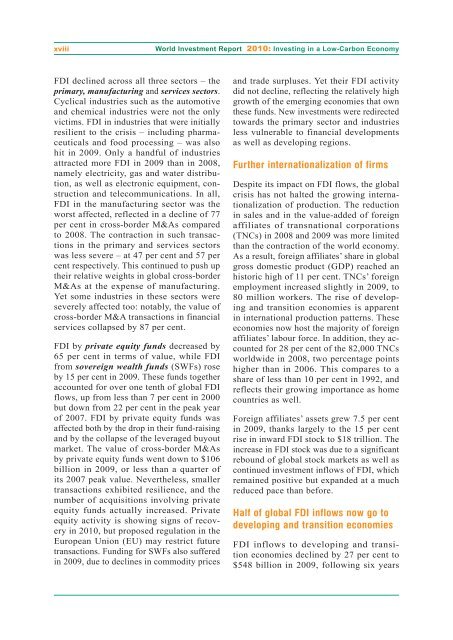UN World Investment Report 2010 - Office of Trade Negotiations
UN World Investment Report 2010 - Office of Trade Negotiations
UN World Investment Report 2010 - Office of Trade Negotiations
Create successful ePaper yourself
Turn your PDF publications into a flip-book with our unique Google optimized e-Paper software.
xviii<br />
FDI declined across all three sectors – the<br />
primary, manufacturing and services sectors.<br />
Cyclical industries such as the automotive<br />
and chemical industries were not the only<br />
victims. FDI in industries that were initially<br />
resilient to the crisis – including pharmaceuticals<br />
and food processing – was also<br />
hit in 2009. Only a handful <strong>of</strong> industries<br />
attracted more FDI in 2009 than in 2008,<br />
namely electricity, gas and water distribution,<br />
as well as electronic equipment, construction<br />
and telecommunications. In all,<br />
FDI in the manufacturing sector was the<br />
worst affected, reflected in a decline <strong>of</strong> 77<br />
per cent in cross-border M&As compared<br />
to 2008. The contraction in such transactions<br />
in the primary and services sectors<br />
was less severe – at 47 per cent and 57 per<br />
cent respectively. This continued to push up<br />
their relative weights in global cross-border<br />
M&As at the expense <strong>of</strong> manufacturing.<br />
Yet some industries in these sectors were<br />
severely affected too: notably, the value <strong>of</strong><br />
cross-border M&A transactions in financial<br />
services collapsed by 87 per cent.<br />
FDI by private equity funds decreased by<br />
65 per cent in terms <strong>of</strong> value, while FDI<br />
from sovereign wealth funds (SWFs) rose<br />
by 15 per cent in 2009. These funds together<br />
accounted for over one tenth <strong>of</strong> global FDI<br />
flows, up from less than 7 per cent in 2000<br />
but down from 22 per cent in the peak year<br />
<strong>of</strong> 2007. FDI by private equity funds was<br />
affected both by the drop in their fund-raising<br />
and by the collapse <strong>of</strong> the leveraged buyout<br />
market. The value <strong>of</strong> cross-border M&As<br />
by private equity funds went down to $106<br />
billion in 2009, or less than a quarter <strong>of</strong><br />
its 2007 peak value. Nevertheless, smaller<br />
transactions exhibited resilience, and the<br />
number <strong>of</strong> acquisitions involving private<br />
equity funds actually increased. Private<br />
equity activity is showing signs <strong>of</strong> recovery<br />
in <strong>2010</strong>, but proposed regulation in the<br />
European Union (EU) may restrict future<br />
transactions. Funding for SWFs also suffered<br />
in 2009, due to declines in commodity prices<br />
<strong>World</strong> <strong>Investment</strong> <strong>Report</strong> <strong>2010</strong>: Investing in a Low-Carbon Economy<br />
and trade surpluses. Yet their FDI activity<br />
did not decline, reflecting the relatively high<br />
growth <strong>of</strong> the emerging economies that own<br />
these funds. New investments were redirected<br />
towards the primary sector and industries<br />
less vulnerable to financial developments<br />
as well as developing regions.<br />
Further internationalization <strong>of</strong> firms<br />
Despite its impact on FDI flows, the global<br />
crisis has not halted the growing internationalization<br />
<strong>of</strong> production. The reduction<br />
in sales and in the value-added <strong>of</strong> foreign<br />
affiliates <strong>of</strong> transnational corporations<br />
(TNCs) in 2008 and 2009 was more limited<br />
than the contraction <strong>of</strong> the world economy.<br />
As a result, foreign affiliates’ share in global<br />
gross domestic product (GDP) reached an<br />
historic high <strong>of</strong> 11 per cent. TNCs’ foreign<br />
employment increased slightly in 2009, to<br />
80 million workers. The rise <strong>of</strong> developing<br />
and transition economies is apparent<br />
in international production patterns. These<br />
economies now host the majority <strong>of</strong> foreign<br />
affiliates’ labour force. In addition, they accounted<br />
for 28 per cent <strong>of</strong> the 82,000 TNCs<br />
worldwide in 2008, two percentage points<br />
higher than in 2006. This compares to a<br />
share <strong>of</strong> less than 10 per cent in 1992, and<br />
reflects their growing importance as home<br />
countries as well.<br />
Foreign affiliates’ assets grew 7.5 per cent<br />
in 2009, thanks largely to the 15 per cent<br />
rise in inward FDI stock to $18 trillion. The<br />
increase in FDI stock was due to a significant<br />
rebound <strong>of</strong> global stock markets as well as<br />
continued investment inflows <strong>of</strong> FDI, which<br />
remained positive but expanded at a much<br />
reduced pace than before.<br />
Half <strong>of</strong> global FDI inflows now go to<br />
developing and transition economies<br />
FDI inflows to developing and transition<br />
economies declined by 27 per cent to<br />
$548 billion in 2009, following six years

















